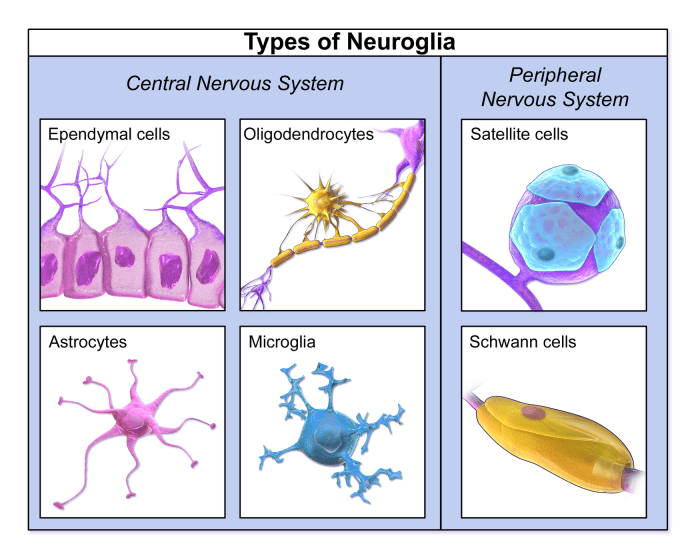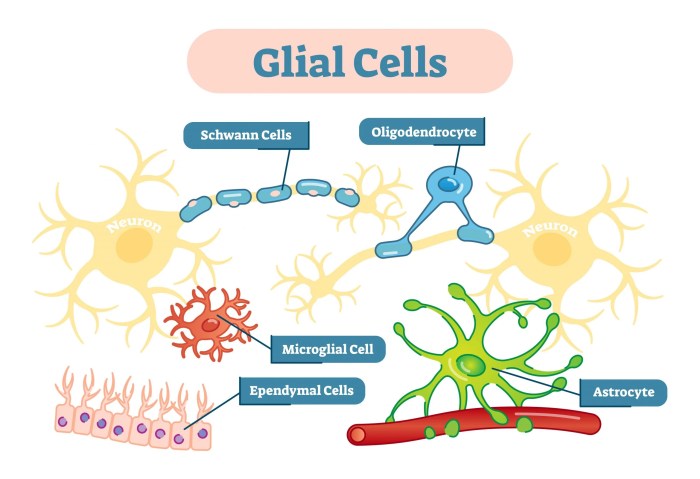Match each glial cell type with its location and function. Glial cells are a diverse group of cells that provide support and protection for neurons in the central and peripheral nervous systems. They play a crucial role in maintaining homeostasis, regulating neurotransmission, and providing immune surveillance.
This article will delve into the specific locations and functions of astrocytes, oligodendrocytes, microglia, and Schwann cells, highlighting their unique contributions to neural health and function.
Glial Cell Types

Glial cells are a diverse group of cells that provide support and protection for neurons in the central and peripheral nervous systems. They make up about 90% of the cells in the nervous system and play a crucial role in maintaining brain homeostasis, regulating neuronal activity, and responding to injury and disease.
There are several types of glial cells, each with its unique structure and function. The main types of glial cells include astrocytes, oligodendrocytes, microglia, and Schwann cells.
Glial Cell Locations

| Glial Cell Type | Location | Function |
|---|---|---|
| Astrocytes | Central nervous system (CNS) | Blood-brain barrier maintenance, neurotransmitter regulation, ion homeostasis |
| Oligodendrocytes | CNS | Myelin formation, axonal support |
| Microglia | CNS | Immune surveillance, phagocytosis, cytokine production |
| Schwann cells | Peripheral nervous system (PNS) | Myelin formation, axonal support |
Astrocytes
Astrocytes are the most abundant type of glial cell in the CNS. They are star-shaped cells with numerous processes that extend throughout the brain and spinal cord. Astrocytes perform a variety of important functions, including:
- Maintaining the blood-brain barrier, which regulates the entry of substances from the blood into the brain
- Regulating neurotransmitter levels in the synaptic cleft
- Maintaining ion homeostasis by controlling the extracellular concentration of potassium and calcium ions
- Providing structural support for neurons and blood vessels
- Participating in immune responses and repair processes
Oligodendrocytes
Oligodendrocytes are responsible for producing myelin, a fatty substance that insulates axons and increases the speed of nerve impulses. They are found in both the CNS and PNS.
In the CNS, oligodendrocytes extend their processes to wrap around the axons of multiple neurons, forming a multilayered myelin sheath. In the PNS, Schwann cells perform this function.
Myelination is essential for the proper functioning of the nervous system. It allows for faster and more efficient transmission of nerve impulses, and it also protects axons from damage.
Microglia
Microglia are the resident immune cells of the CNS. They are constantly scanning the brain and spinal cord for signs of damage or infection. When they detect a problem, they become activated and release a variety of cytokines and chemokines that recruit other immune cells to the site of injury or infection.
Microglia also play a role in phagocytosis, the process of engulfing and destroying foreign particles or damaged cells. They are essential for maintaining the health and integrity of the CNS.
Schwann Cells, Match each glial cell type with its location and function
Schwann cells are the myelin-producing cells of the PNS. They are responsible for wrapping axons with myelin, which increases the speed of nerve impulses and protects axons from damage.
Schwann cells also play a role in nerve regeneration. When a nerve is damaged, Schwann cells can help to guide the regenerating axon back to its target.
Frequently Asked Questions: Match Each Glial Cell Type With Its Location And Function
What are the main types of glial cells?
The main types of glial cells are astrocytes, oligodendrocytes, microglia, and Schwann cells.
What is the function of astrocytes?
Astrocytes are responsible for maintaining the blood-brain barrier, regulating neurotransmitter activity, and providing structural support for neurons.
Where are oligodendrocytes located?
Oligodendrocytes are found in the central nervous system and are responsible for myelinating axons, which speeds up the transmission of electrical signals.
